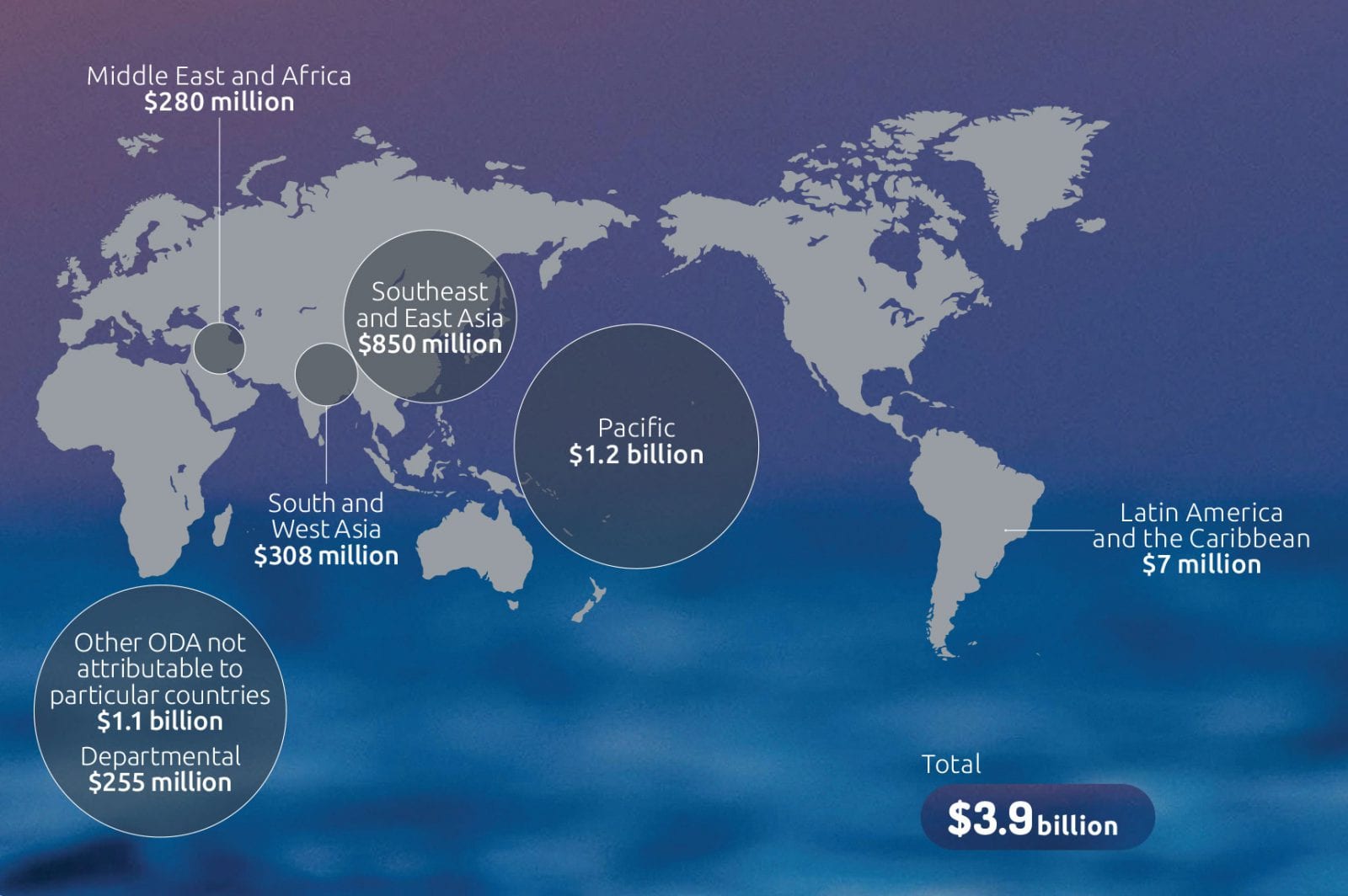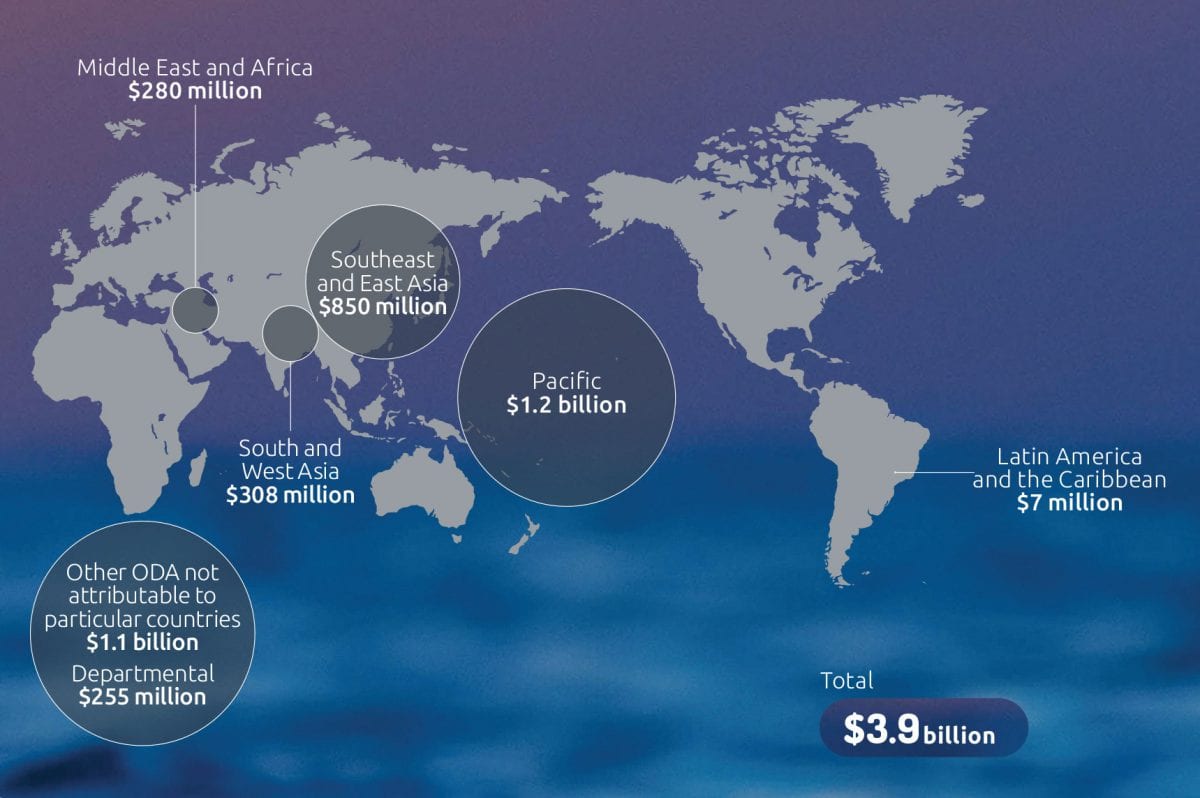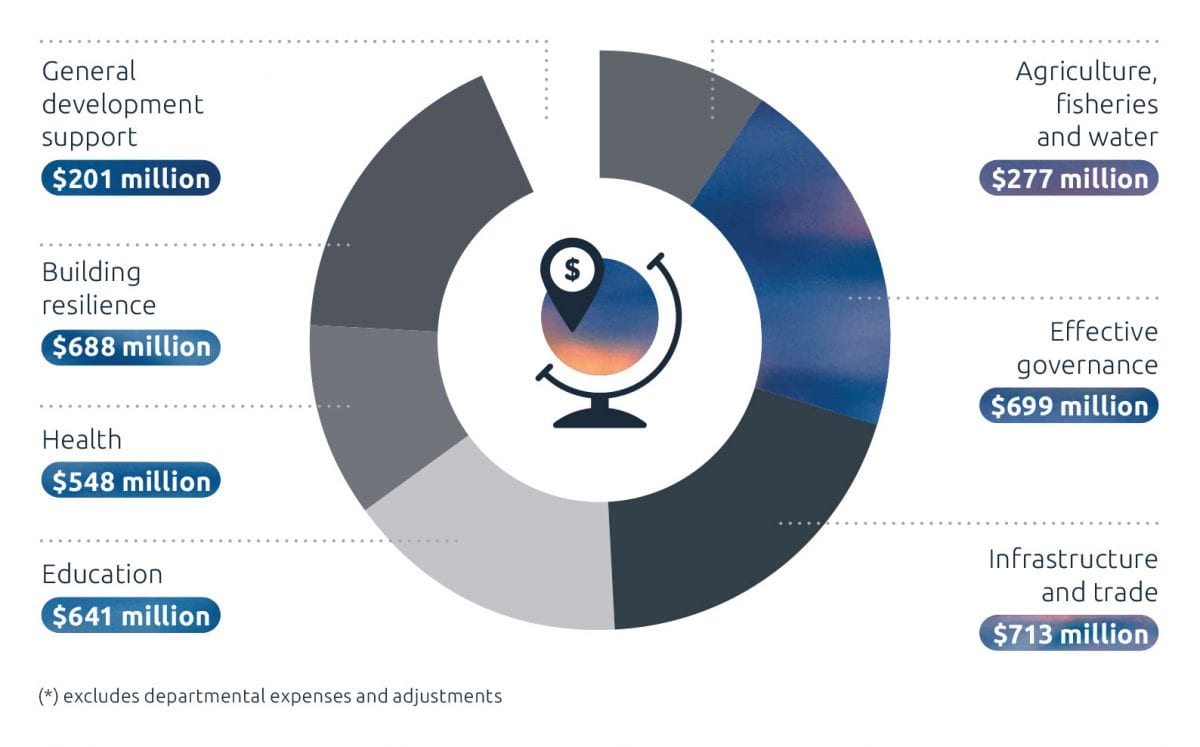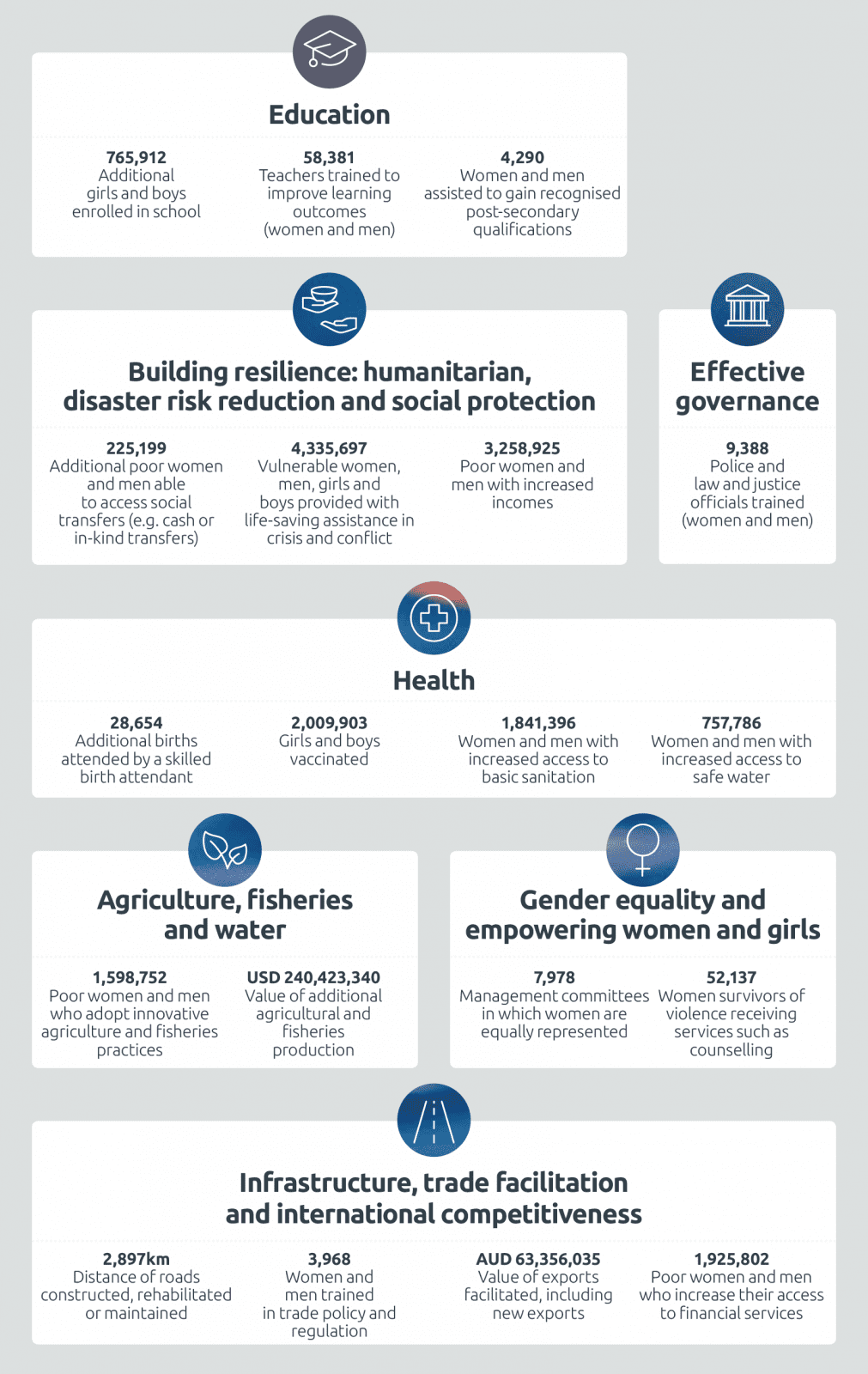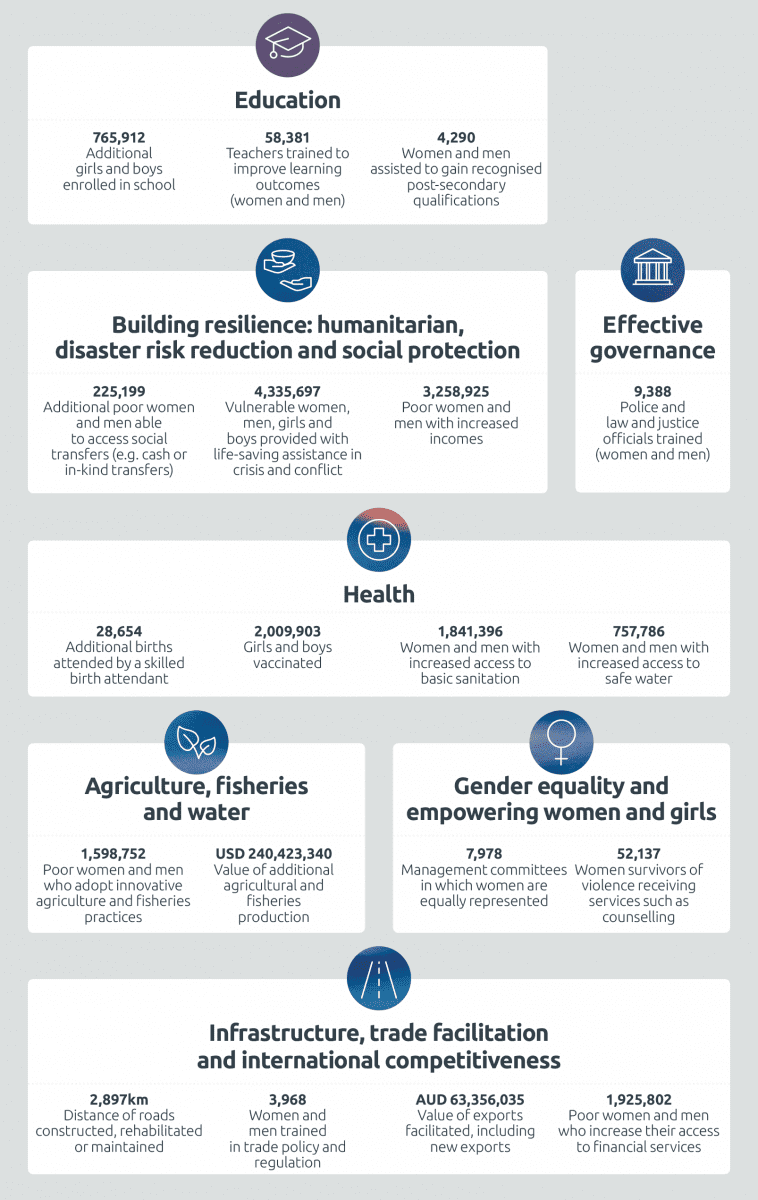Australia’s development assistance is essential to our vision of an open, inclusive and prosperous Indo-Pacific. It delivers results and serves our national interests by contributing to sustainable economic development and poverty reduction.
The majority of our neighbours are middle-income countries with enormous potential. Most are navigating the challenges, vulnerabilities and risks that come with a growing economy. Each faces different challenges, so country context and their priorities shape our support.
![Evacuees receiving assistance from the department following the Ambae volcano eruption in Vanuatu [IPPF/Alana Holmberg]](../../../wp-content/uploads/2019/10/Photo-21-Priority-4-break-1024x907.jpg)
We magnify Australia’s ability to affect pressing regional and global problems through our development program—bilaterally, regionally and in multilateral forums. This includes our efforts to meet the Sustainable Development Goals.
A rigorous performance framework—Australian aid: promoting prosperity, reducing poverty, enhancing stability—ensures our development assistance is effective, transparent and value-for-money.
Sustainable Development Goals
In July Australia delivered its first report to the United Nations on our progress towards meeting the Sustainable Development Goals (SDGs) by 2030.
The 17 goals set out a global approach to reducing poverty, promoting sustainable development and ensuring peace and prosperity. Australia’s Voluntary National Review was a ‘whole-of-Australia’ report that included efforts made by business, civil society, academia, and communities, as well as by government. Our development program supports partners to make progress towards achieving the SDGs. Country and civil society representatives commended Australia’s inclusion of Indigenous Australians and the business community in its presentation to the United Nations.
Growing economies and reducing poverty
While the Indo-Pacific is one of the most economically dynamic regions in the world, it is also home to almost half of the world’s poorest people, with nearly 330 million living in extreme poverty in the Pacific and Southeast Asia. We want our neighbours to do well, as prosperity and stability foster peace and security in our region, and contribute to increased two-way trade.
| Performance measures | How we rate our performance* |
|---|---|
| Australian interests are promoted by our development program, including enhanced sustainable economic growth and poverty reduction in the Indo-Pacific. | On track |
| 90 per cent of country attributable aid spent in the Indo-Pacific. | Achieved |
Source: Corporate Plan 2018–19 p. 16 | Funding: PBS 2018–19 programs 1.2 and 1.3
Our performance
In 2018–19 the department delivered $3.9 billion of the Australian Government’s $4.3 billion development assistance program, with other departments delivering the remainder. We delivered 91 per cent of country attributable aid in the Indo-Pacific, above our 90 per cent target. We rate our performance against these measures as ‘on track’, evidenced by rigorous program design, implementation and monitoring processes that ensure we deliver results that contribute to sustainable economic growth and reducing poverty.
Ensuring the department has the international development and aid management capability to deliver our development assistance efficiently and effectively remains a high priority—this is a work in progress.
Pacific
In 2018–19 we took our partnership with the Pacific to a new level. The department’s $1.2 billion investment was our largest annual development spend in the Pacific. A new, dedicated Office of the Pacific is leading our deeper engagement in the region.
Sustaining economic growth, boosting education and jobs, pursuing gender equality, preventing major disease, adapting to climate change and preparing for disasters are major challenges in the Pacific. Overcoming them requires effective, inclusive government, leadership and at times, difficult reforms. Strengthening governance and economic reform are a key focus of our partnerships in the region. Some highlights of our work are outlined in the following pages, but there are many more.
For example, we supported elections in Fiji and Solomon Islands, requested by their governments. Samoa has a new parliament house with Australia’s assistance. The department is promoting the inclusion of women as leaders and decision-makers—and training and mentoring potential candidates—through our 10-year $320 million dollar investment in the Pacific Women Shaping Pacific Development initiative.
Our support is strengthening governance in Papua New Guinea. Through our partnership, improvements to the tax system have allowed Papua New Guinea to increase tax revenue by $130 million. In Vanuatu, our assistance with reforms has boosted government revenue with a 19 per cent increase in receipts from Value Add Tax. Results like these boost resources for partner governments to deliver services such as health and education—also improving the operating environment for the private sector, and laying the foundations for future economic growth.
Justice services have improved in Solomon Islands through the department’s collaboration with local communities and the World Bank. Almost 7,000 Solomon Islanders across two provinces have access to informal justice services. Seventy-seven per cent of those surveyed said they had experienced improvements in community grievance mechanisms.
Another focus of our work is catalysing the private sector to drive economic growth. We are working with Australian businesses and others to develop infrastructure across the region with the establishment of the $2 billion Australian Infrastructure Financing Facility for the Pacific. As the majority funder of the Coral Sea cable from Australia to Solomon Islands and Papua New Guinea, we are helping provide faster, cheaper and more reliable communications infrastructure for both countries. Due for completion in late 2019, this will enable entrepreneurship, digital skills and integration into the global marketplace.
Fiji’s green bond
Around 43,000 Fijians in 120 rural communities now have clean water, more than 100 schools have been rebuilt and 170 bridges have been rehabilitated through projects funded in 2018–19 by the Fijian Government’s green bond, developed with support from the department.
Fiji is the first developing country in the world to issue a sovereign green bond. It attracted $26 million in climate finance when the bond was listed on the London Stock Exchange in April 2018. Drawing finance to the Pacific is important to encourage economic growth and combat the impacts of climate change. Technical assistance to develop the green bond was provided through the $13 million DFAT–International Finance Corporation Fiji Partnership. The bond received the 2018 Green Bond Pioneer Award.
![Minister for International Development and the Pacific Alex Hawke with the Crown Prince of Tonga Tupouto’a ‘Ulukalala in Perth [Department of Defence]](../../../wp-content/uploads/2019/10/Photo-22-1024x718.jpg)
We also focus on improving health and education to reduce poverty and underpin sustainable economic growth. For example, with our support, school grants in Vanuatu have expanded the number of years of education available to over 40,000 primary school children. Enrolment rates have increased, including a 12 per cent increase in kindergarten enrolments.
An example of our work to improve health was our partnership with the Global Polio Eradication Initiative, World Health Organization and UNICEF ($16 million) to immunise 3.3 million children in Papua New Guinea following an outbreak of vaccine-derived poliovirus. This helped prevent the further spread of the disease. We also supported the partnership between the Medicines for Malaria Venture and the private pharmaceutical company GSK, to develop a new single-dose cure for malaria caused by Plasmodium vivax through our Indo-Pacific Centre for Health Security. This strain of malaria affects some eight million people in the Indo-Pacific. The new cure will help relieve the enormous malaria burden felt in countries like Papua New Guinea and Solomon Islands.
Pacific Island Food Revolution
Pacific Island Food Revolution is the reality TV series and multimedia campaign that is encouraging healthy eating across the Pacific. Teams compete to create easy, delicious and healthy dishes, filmed in Fiji, Samoa, Tonga and Vanuatu.
The show is broadcast to over 24 stations across the Pacific and will also be available to Australian and New Zealand viewers. Since its launch in April, Pacific Island Food Revolution has attracted a steady following of more than 22,000 on Facebook.
Research indicates early signs of the program having impact—especially among women—with a 146 per cent increase in preference for healthy traditional options.
The initiative is co-funded by the department’s innovationXchange and New Zealand’s Ministry of Foreign Affairs and Trade, to help Pacific island countries reduce their high rates of chronic illnesses including diabetes, high blood pressure and coronary diseases.
![Fijian chefs Shamim Ali and Manasa Bolawaqatabu during an episode of reality TV series Pacific Island Food Revolution [PIFR]](../../../wp-content/uploads/2019/10/Photo-23-1024x683.jpg)
Southeast Asia
Although Southeast Asia is one of the fastest-developing regions in the world, growth is uneven and often inequitable. Our $850 million in development assistance in 2018–19 responded to the diverse needs of the region. In fast-growing economies such Indonesia, the Philippines and Vietnam, we supported difficult governance reforms and facilitated finance for much needed infrastructure. In lower-income countries, we focused on service delivery and poverty reduction.
For example in Indonesia we provided specialist advisers to help improve government systems. Our investments with the World Bank and the Asian Development Bank catalysed an additional $2 billion from international partners to build and maintain better infrastructure. To improve economic governance, we drew on Australian Treasury expertise to support Indonesia to develop its first tax expenditure statement, allowing greater public scrutiny of tax exemptions and creating a more transparent system. Indonesia is only the second ASEAN country to publish a tax expenditure report.
![Village registration officers in South Sulawesi, Indonesia collecting information from a villager [KOMPAK/Yusuf Ahmad]](../../../wp-content/uploads/2019/10/Photo-24-1024x587.jpg)
Our advocacy and support to policy makers in the Philippines assisted with the passage of a new universal health care law. As a result, the Philippines’ population of 105 million now benefits from the national health insurance system, receiving free primary health services. This will allow for early detection of illnesses, better chances of treatment and greater protection from financial hardship for poor households.
Transport in Vietnam
In early 2019 the Government of Vietnam asked the department’s Aus4Transport infrastructure program (worth $30 million over four years) to deliver detailed designs for the Central Highland Connectivity Improvement Project and the Northern Mountain Provinces Transport Connectivity Project. This helped Vietnam access USD400 million from the World Bank and Asian Development Bank. This 350-kilometre network of critical roadways in four provinces will contribute to economic growth by connecting rural farmers to markets in Hanoi, and supporting the increased demand for tourism in these regions.
According to an independent evaluation, the department’s focus on institutional governance in Asian middle-income countries has helped facilitate reforms where there is partner appetite (dfat.gov.au/investing-in-regional-partnerships). The evaluators recommended we more clearly articulate the objectives of our economic partnerships to make our development, trade and diplomatic efforts more consistent. They found more ambitious partnerships would be possible if the department had strengthened staff capabilities.
We contributed to the delivery of improved educational outcomes for our partners in Southeast Asia’s least-developed countries. Our funding in Myanmar supported more than 48,575 monastic and government schools in all states and regions across the country. It also helped more than nine million students get better access to schools, resources and facilities. In Timor-Leste, access to education has improved but teacher quality remains a challenge. We worked with the government to implement a teacher quality program, which is helping to improve the literacy and numeracy of primary school students, including 108 school leaders, 542 teachers and around 12,000 students.
![First Assistant Secretary Julie Heckscher and Senior Program Officer Bounmy Souvannalath visiting a primary school in Vientiane, Laos [DFAT]](../../../wp-content/uploads/2019/10/Photo-25-1024x683.jpg)
South and West Asia
In collaboration with regional governments, civil society and the private sector we delivered $308 million in development assistance in South and West Asia in 2018–19. We collaborated to build climate change resilience, improve food, energy and water resource management, facilitate increased trade and advance the empowerment of women.
For example, through our South Asia Regional Trade Facilitation Program, the department improved transport infrastructure to increase the flow of goods and services between Bhutan, Bangladesh, India and Nepal. It also enhanced access to markets for mostly rural populations. We expanded women’s economic participation by improving river crossings and island ferry services, delivering public information campaigns on safety issues for women traders, and developing educational programs for female traders on the law and their rights.
In Afghanistan, in the face of significant security and access challenges, we supported the Afghan Government to deliver basic services to its population. We supported efforts to change community perceptions on violence against women by partnering with The Asia Foundation to train 120 religious scholars and challenge harmful gender norms. Sermons on women’s rights by religious scholars such as these have been instrumental in improving understanding and acceptance of women’s rights, which can in turn help reduce violence against women.
![Children in Madhya Pradesh, India, where the department is helping to develop the world’s largest grid-connected solar power facility [IFC/Sayantoni Palchoudhuri]](../../../wp-content/uploads/2019/10/Photo-26_CMYK-1024x682.jpg)
Gender equality and women’s empowerment
Across the development program, we spent $1.3 billion on investments that helped promote gender equality and women’s empowerment.
We aim to incorporate gender equality measures into at least 80 per cent of all development activities. This enhances women’s voices in decision-making and promotes their economic empowerment. We also supported a number of investments to promote gender equality including:
- awareness sessions on ending violence against women and children, which reached over 20,000 people across Vanuatu’s six provinces. We helped develop the skills of 310 Vanuatu businesses (60 per cent operated by women) across four provinces, improving income generation in key productive sectors
- providing 49,515 women and girls in Myanmar in 2018 with gender-based violence support and response activities, and reproductive health services. This work is addressing protection concerns of the most vulnerable internally displaced people and host communities
- our investment in the Impact Investment Exchange Asia’s Women’s Livelihood Bond series—the world’s first listed bond with a dual focus on financial and social returns—provides loans for social enterprises that are women-owned or have marginalised women beneficiaries. The initiative impacted 144,800 women in 2018
- our gender equality fund ($55 million in 2018–19) which is contributing to innovative investment partnerships to promote women’s economic empowerment.
![Teacher at Mainohana Secondary School, Papua New Guinea, delivering a lesson from the department’s Rights, Respect and Resilience project [ChildFund]](../../../wp-content/uploads/2019/10/Photo-27_CMYK.jpg)
Africa and the Middle East
While the Indo-Pacific is our primary focus, we deliver targeted development programs outside our neighbourhood to meet our national interests and those of our partners. In 2018–19 we delivered $247 million to countries outside the Indo-Pacific.
Our programs in Africa build enduring people-to-people links with Australia, support economic engagement and promote gender equality. The Australia Awards are our largest African development investment, promoting capability, increasing awareness of Australia and building life-long relationships. In 2018–19 about 480 outstanding professionals from government, civil society and the private sector completed courses in Australia, gaining skills to contribute in their home countries and exposing them to Australian enterprises. An independent evaluation in 2018 of Australia Awards in Africa (dfat.gov.au/australia-awards-in-africa-independent-mid-term-evaluation) found the program is strengthening developing country capacity in line with Australia’s foreign policy objectives.
We supported the Middle East peace process and aspirations for an agreed two-state solution to the conflict between Israel and the Palestinians through our development assistance to the Palestinian Territories. Our $43 million program in 2018–19 supported basic services including health and education, and livelihoods for Palestinians, promoting stability and economic growth. This program also contributed to increasing the economic independence and self-sufficiency of women in the Palestinian Territories through projects that directly supported the economic power of women and girls.
Disability inclusion
People with disability are among the poorest and most marginalised of groups in developing countries. Their inclusion as active participants in development processes benefits families and communities, reduces the impacts of poverty and contributes to a country’s economic growth.
Australia is an international leader in disability-inclusive development and was the first donor country to have a strategy to make development assistance disability-inclusive. An independent evaluation of our strategy (dfat.gov.au/development-for-all-evaluation) found progress is being made—about 40 per cent of our investments are disability-inclusive—with important contributions to improving the lives of people with disabilities. Efforts in other areas have been less successful, reflecting the difficulty of the challenges to be addressed.
The department received an award from the International Disability Alliance for outstanding contributions for the advancement of the rights of persons with disabilities. Our international advocacy is credible, effective and influential. For example, with Australia’s support, the United Nations launched a new disability inclusion strategy in June 2019.
Working with others
By collaborating with multilateral organisations, the private sector, non-government organisations and, importantly, leveraging the skills and know-how of Australians, we expand the reach and impact of our development program. We are selective in our choice of partners, working with those that can bring the greatest value to our region.
Multilateral partners
Our closest partners in the region rely on multilateral organisations for large-scale finance and infrastructure analysis and expertise. In 2018–19 we worked with the Asian Development Bank and World Bank Group to deliver more finance to the region. Asian Development Bank concessional finance to 12 Pacific countries increased by USD168 million, bringing the total value of its Pacific portfolio to USD2.9 billion. Fiji gained access to concessional funding from the World Bank this year—a change we have advocated for strongly—and will receive an extra USD21 million annually to recognise its vulnerability as a small island economy. This means Fiji will gain access to support from other funding sources too, including being eligible for rapid funds in the aftermath of a natural disaster to help with response and recovery.
In 2018–19 we invested $584 million in economic infrastructure and access to infrastructure finance. This included support for the World Bank’s Global Infrastructure Facility and the Private Infrastructure Development Group (PIDG). Our partnership with PIDG helped develop close to 30 projects across South and Southeast Asia, mobilising an additional USD170 million in private capital investments. This will support sustained economic growth in the region by boosting energy production, improving waste management and extending agriculture production.
In addition to leveraging financing and expertise, multilateral organisations can achieve economies of scale that no individual actor can achieve alone. This is most evident in the health sector where pooling procurement of health commodities has provided countries in our region with access to better prices. We provided $220 million to the Global Fund to Fight AIDS, Tuberculosis and Malaria—the world’s largest multilateral funder of health programs in developing countries. We also supported Gavi, the Vaccine Alliance, pledging $250 million to its 2016–2020 replenishment. Independent reviews of Gavi activities show that every US dollar invested in vaccines saves USD18 in terms of healthcare costs, lost wages and lost productivity due to illness.
![Registered nurse Miriam Nampil receiving the first vaccine delivered by drone to Cook’s Bay, Vanuatu [UNICEF]](../../../wp-content/uploads/2019/10/Photo-28-1024x576.jpg)
The private sector
We work with private sector partners in more diverse and varied ways, identifying opportunities for new forms of collaboration and innovative approaches to development challenges. For example, our Business Partnerships Platform has benefited 5.37 million people (54 per cent women) across 14 countries through 23 partnerships, and our investments through the innovationXchange continue to yield lessons on new ways of working.
In partnership with cruise ship company Carnival Australia and social business consultancy The Difference Incubator, the department aims to accelerate more than 10 tourism businesses in Vanuatu—creating jobs and investment—through a Pacific Tourism Development Pilot (marketed as YuMi Tourism Partners). The pilot won a national Shared Value Award and has the potential to generate $1.5 million in economic impact annually in Vanuatu.
Another example is our partnership with the New Zealand Government and the International Finance Corporation to develop a new training and recruitment program for SolTuna, a large Solomon Islands company. SolTuna employs over 1,800 workers, 64 per cent of them women, but absenteeism and high staff turnover held back the company’s productivity. By addressing issues such as family health and violence, and low financial literacy, staff working conditions improved and absenteeism substantially reduced. Company earnings rose by $1.58 million through increased productivity. The number of women in management or leadership roles more than tripled from nine to 32. The number of women in jobs traditionally held by men more than doubled.
Civil society
Non-government organisations (NGOs) are vital partners in our efforts to encourage greater prosperity and stability in our region. Australian, international and local NGOs have been key partners in the development program for more than 40 years, working together to support sustainable economic growth and reduce poverty. NGOs have strong connections to local communities, access to remote, fragile and conflict-affected areas, and deep development expertise.
Our Civil Society Water, Sanitation and Hygiene Fund supported 13 civil society organisations to deliver 29 water, sanitation and hygiene projects in 19 countries in Asia, the Pacific and southern Africa. Over five years, the fund improved services for 4.31 million poor and vulnerable people including 73,000 people living with disabilities. It did this by strengthening the capacity of people from communities, government and the private sector to deliver water, sanitation and hygiene services.
For example, iDE provided access to new toilets to 700,000 people in Cambodia—more than double the original target. iDE not only promoted the use of toilets in the community but also worked with businesses to provide affordable solutions such as producing Lego-like interlocking bricks that minimised the need for mortar and saved time and money.
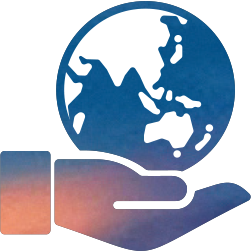 Australian NGO Cooperation Program
Australian NGO Cooperation Program
The department’s Australian NGO Cooperation Program (ANCP) provided $132 million to 57 accredited NGOs to implement 454 projects in 2018–19. A total of 2,000 local partners in over 60 countries participated in project delivery. Eighty per cent of ANCP’s work is in the Indo-Pacific, with the remainder predominantly in Africa. Projects included:
- teaching children about respectful relationships
- coordinating menstrual hygiene and family planning services to help girls stay in school
- empowering women to be involved in climate change decision-making
- supporting dignified and safe repatriation for refugee women.
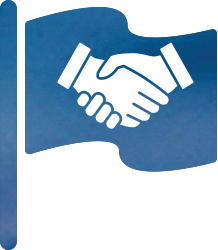 Australian Aid: Friendship Grants
Australian Aid: Friendship Grants
The $3.5 million inaugural round of Australian Aid: Friendship Grants enabled 46 community organisations from across Australia to expand or enhance their international development work in 15 countries in the Indo-Pacific. We partnered with Australian community organisations, leveraging their influence and expertise to boost our program effectiveness. Friendship Grants support strong relationships in the Indo-Pacific and make a tangible difference to people and their communities. Outcomes from the first round include:
- disadvantaged women in Nepal received hospitality training to boost job opportunities
- women in Papua New Guinea were taught how to sew reusable and affordable sanitary kits to help generate income for local community groups
- improved water supply in Solomon Islands through drilling wells.
 Australian Volunteers Program
Australian Volunteers Program
In 2018–19 the Australian Volunteers Program continued delivering results. We deployed over 1,000 skilled Australians to support 600 partner organisations across 26 countries, helping communities and boosting strong people-to-people links. Fifty per cent of volunteers went to Asia, 41 per cent to the Pacific and Timor-Leste, and nine per cent to Africa. Australian volunteers are a tangible expression of Australia’s engagement in the region.
Responding to humanitarian crises and building resilience
Humanitarian crises undermine growth, reverse hard-won development gains, increase poverty, and can result in long-term instability. Such crises can have profoundly negative consequences for regional trade and health security.
Our region is among the most disaster-prone in the world, and climate change is exacerbating this trend.
Australia is a leader in disaster response because of our capacity to quickly mobilise humanitarian relief supplies—including Department of Defence assets and personnel—as well as humanitarian expertise, shelter materials or emergency medical teams.
| Performance measure | How we rate our performance* |
|---|---|
| Timely and effective responses to humanitarian crises, including an enhanced Indo-Pacific ability to prepare, respond and recover from crises. | On track |
Source: Corporate Plan 2018–19 p. 17 | Funding: PBS 2018–19 programs 1.2 and 1.3
Our performance
In 2018–19 the department provided approximately $410 million to help communities affected by humanitarian crises and to boost the capacity of countries in our region to prepare for and become more resilient to disasters. We ensure Australia meets its commitment to respond to requests for assistance within 48 hours. We rate our performance against this measure as ‘on track’.
The department manages a $50 million Disaster READY program that supports the preparedness of Pacific and Timor-Leste communities for natural disasters. The program helped establish safe evacuation centres across Solomon Islands, strengthened early warning systems in Timor-Leste, developed provincial preparedness plans in Papua New Guinea and supported tsunami drills in Vanuatu. Just two months after the drills, communities reacted to a real tsunami alarm, moving swiftly to higher ground.
Through our Australia Assists program, the department deployed 87 civilian specialists to support humanitarian efforts, including 38 working with Pacific governments and communities on issues such as disaster risk management, gender and disability, and election monitoring. For example, the department deployed 10 humanitarian specialists to support the Vanuatu Government’s response to the Ambae Volcano disaster in August. Following significant volcanic activity the specialists helped to develop and implement a plan to evacuate 8,500 people from Ambae to neighbouring islands.
The department fosters a ‘Pacific supporting the Pacific’ approach where countries help their neighbours when disasters strike. Our support helped the Fiji Emergency Medical Assistance Team (FEMAT) become the first WHO-verified team in the Pacific. FEMAT can now mobilise a self-sustaining field hospital and team of 20 highly trained doctors, nurses and logisticians to be more agile, responding to Pacific emergencies within 48 hours.
We demonstrated the value of disaster preparedness when Super Typhoon Mangkhut struck the Philippines on 15 September. More than 1.5 million people were affected, with 127 fatalities. We responded rapidly when the Philippines Government asked for our help and released pre-positioned humanitarian supplies to the Philippines Red Cross. This supported 5,000 families in the 10 most affected provinces. Days later we released a further contribution of prepositioned sexual and reproductive health kits through the United Nations Population Fund to support over 1,000 pregnant and breastfeeding women.
Sulawesi earthquake
On the evening of 28 September, a 7.7 magnitude earthquake rocked the island of Sulawesi in Indonesia unleashing a tsunami that affected more than 2.4 million people.
The Indonesian Government declared the death toll to be 4,340 people and at least 240,000 were displaced.
We were one of the first to respond. Within 24 hours, nine C-130 Australian Defence Force aircraft began transferring relief supplies from Darwin to Indonesia, providing shelter kits, tarpaulins, blankets and generators for around 30,000 people.
The department coordinated the whole-of-government effort, providing a $10.25 million package of assistance delivered with the Indonesian Government, the ASEAN Coordinating Centre for Humanitarian Assistance and local civil society organisations such as the Indonesian Red Cross.
Our funding helped United Nations and non-government partners deliver health, sanitation and hygiene solutions for more than 165,000 people. Under the department-led Australian Humanitarian Partnership, our NGOs worked with Indonesian partners to ensure the most vulnerable—including women, children and people with a disability—were not left behind.
![Woman in Donggala District, Indonesia waiting for distribution of Australian relief supplies following the Sulawesi earthquake [CARE/PKPU Human Initiative/Wiwik Widyastuti]](../../../wp-content/uploads/2019/10/Photo-29.png)
Australia is working with Myanmar, Bangladesh, other regional partners and the broader international community towards a long-term and durable solution to the Rohingya crisis. With 700,000 Rohingya forcibly displaced from Myanmar since 2017, there are now over 900,000 Rohingya refugees in Bangladesh. The department provided $60 million to Bangladesh and $24 million for the Rohingya crisis and other crises in Myanmar in 2018–19. This funding supported counselling and medical services to women and girls who had experienced violence, food and nutrition focusing on children under five and breastfeeding women, and clean water, shelter and health and sanitation services.
The humanitarian situation in Afghanistan continued to deteriorate. In April 2018 a drought was declared across two thirds of the country, creating food security challenges for 13.5 million people, of whom 3.6 million face critical food shortages. In partnership with the World Food Programme, we provided lifesaving food and water to 5.25 million Afghans in drought-affected provinces. Working with the International Organization for Migration, we assisted over 2,000 vulnerable families (11,536 individuals) who returned to Afghanistan in 2018–19. Our funding is governed by a three-year strategy, providing certainty to a small number of partners who are addressing the protracted crisis, principally along the Afghanistan–Pakistan border.
We are delivering our $220 million, three-year Syria Crisis Humanitarian and Resilience Package. We assisted conflict-affected populations in Syria, and supported Lebanon and Jordan to promote more sustainable futures for the refugees and host communities within their countries. Support included food assistance, improved access to education, inclusion of people with disabilities, women’s empowerment and protection from sexual and gender-based violence. A 2019 independent evaluation found our investment was well designed (dfat.gov.au/syria-humanitarian-response). It found our funding methods, geographic focus and inclusion of resilience programming—as well as our humanitarian assistance—was appropriate.
Effective, transparent and efficient
The department has a strong focus on performance reporting, evaluation, innovation and research, recognising that Australians want assurance that taxpayer funds are used appropriately and in ways that are in our interests, and that funds are not diverted from their intended purpose. Our development program is subject to regular and extensive oversight of financial and program accountability.
| Performance measures | How we rate our performance* |
|---|---|
| An effective, transparent and efficient aid program in line with the Australian aid program’s performance framework, Making Performance Count. | On track |
| Source: Corporate Plan 2018–19 p. 17 | Funding: PBS 2018–19 programs 1.2 and 1.3 | |
| Achievement of significant development results and demonstrated organisational effectiveness, including progress toward the strategic targets contained in the Australian aid program’s performance framework, Making Performance Count. | On track |
| Source: PBS 2018–19 programs 1.2 and 1.3 p. 30 and 31 | Funding: PBS 2018–19 programs 1.2 and 1.3 | |
| Detailed reporting against the performance framework, including individual program and investment performance and multilateral replenishments, will be published annually in the Performance of Australian Aid report. | Acheived |
| Source: PBS 2018–19 programs 1.2 and 1.3 p. 30 and 31 | Funding: PBS 2018–19 programs 1.2 and 1.3 | |
Our performance
Our high-quality development program is underpinned by a comprehensive planning, management and reporting system. In its 2018 review of the Australian development program, the OECD Development Assistance Committee commended the program’s clearly articulated and comprehensive performance monitoring system.
Assessment of our development program and the results we achieve is extensive, rigorous and systematic—with independent checks and balances. Every year, we produce Aid Quality Checks for investments worth more than $3 million. We publish the results on our website in Aid Program Performance Reports (dfat.gov.au/aid-program-performance-reports) along with independent evaluations of investments. This reporting culminates in the annual Performance of Australian Aid report—detailing our progress towards the aid program’s 10 strategic targets, the performance of country, regional and global programs, and presenting performance data for the six priority investment areas of the aid policy framework. The 2017–18 Performance of Australian Aid report was published in April 2019 (dfat.gov.au/performance-of-australian-aid-2017-18). Results for 2018–19 will be published in the Performance of Australian Aid report in early 2020.
The department’s Office of Development Effectiveness monitors the Australian aid program’s performance, evaluates its impact and contributes to international evidence and debate about development effectiveness.
Aid investments are carefully designed and implemented, but are not always as successful as planned. Our monitoring and evaluation systems identify underperformance, and remediation plans are put in place. If these plans fail, investments are cancelled. In 2017–18 Aid Quality Checks, 17 investments were identified as underperforming. By 2018–19, 10 of these had improved their performance, two were completed and five investments had to be cancelled. This year of the 367 investments over $3 million, 10 have been identified as underperforming. Six of these are continuing with remediation plans in place.
